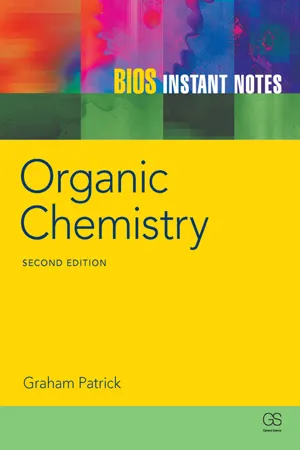Chemistry
R-Groups
R-groups, also known as side chains, are variable groups of atoms attached to the core structure of organic molecules. In the context of organic chemistry, R-groups significantly influence the physical and chemical properties of molecules, such as solubility, reactivity, and biological activity. The unique characteristics of R-groups contribute to the diversity and complexity of organic compounds.
Written by Perlego with AI-assistance
Related key terms
Related key terms
1 of 4
Related key terms
1 of 3
4 Key excerpts on "R-Groups"
- eBook - ePub
- Mark Gibson(Author)
- 2018(Publication Date)
- Academic Press(Publisher)
Belitz et al., 2009 ). Not surprisingly too, molecules and compounds within a particular functional group share certain similar physical and chemical properties such as appearance and melting/boiling points, as well as solubility and chemical reactions characteristics. Lastly, chemical compounds are not restricted to one single functional group; on the contrary, most will include several such functional groupings. As a result, interactions and reactions are potentially complex and complicated and go a long way to explaining the lack of full understanding of chemical reactions of many compounds.So how many functional groups exist? Well, this depends to a large degree on how one separates or divides up the active components within a molecule/compound. If we have several active atoms or atom groups within a single compound and depending on the counting convention, one could end up with literally thousands of functional groupings (Hoenig, 2001 ; Vollhardt and Schore, 2014 ).Homologous series —a homologous series is a group of organic compounds that have similar molecular structures and that differ simply by the number of CH2 units in the main carbon chain. As the compounds within the same group increase, with ever more CH2 units, so the structure's properties will vary slightly depending on its size. Take the property boiling point, for example; while structurally the increasing groups are the same, the boiling points will vary slightly with each new addition of carbon units. Other properties that will also trend with varying additional carbon units include density, melting point, diffusion rate, solubility, refractive index, and conductivity. Another function that is common to compounds in the same homologous series is the presence of common functional group or groups. As a result, the various compounds will behave in a common chemical reactive fashion, although once again taking the above caveat in consideration. In short, one can think a homologous series as a “family” of compounds that have the same general formula, similar molecular structure, and similar chemical properties, further, because they have the same functional group of atoms—hence the same or similar chemical reactions (Belitz et al., 2009 - eBook - ePub
- Jeffrey Gaffney, Nancy Marley(Authors)
- 2017(Publication Date)
- Elsevier(Publisher)
Table 13.2 .Table 13.2 Common Organic Functional GroupsGroup Name Description C C Alkene Hydrocarbon containing a double bond C C Alkyne Hydrocarbon containing a triple bond OH Alcohol Hydroxyl group: hydrogen bonded to oxygen NH2 Amine Nitrogen bonded to two or less alkyl groups X Alkyl halide Alkyl group attached to a halogen O Ether Oxygen bonded to two alkyl groups COH Aldehyde > C O bonded to a hydrogen and an alkyl group CO Ketone > C O bonded to two alkyl groups CO2 H Carboxylic acid > C O bonded to a hydroxyl and an alkyl group COCl Acid halide > C O bonded to a chlorine CO2 Ester > C O bonded to an alkoxy ( OR) and an alkyl group CONH2 Amide > C O bonded to an amine group The chemistry of the alkenes and alkynes, discussed in Section 13.2 , is dependent on their degree of unsaturation. The degree of unsaturation is a measure of how far the structure of a hydrocarbon departs from the structure of a normal alkane structure. For example, benzene (C6 H6 ) has six carbons and six hydrogens. A six carbon normal alkane will follow the general formula of Cn H2n + 2with a molecular formula of C6 H14 - eBook - ePub
Water Quality Data
Analysis and Interpretation
- Arthur Hounslow(Author)
- 2018(Publication Date)
- CRC Press(Publisher)
As the complexity of a ring system increases, finding information on the compound in Chemical Abstracts becomes almost insurmountable because of the difficulty in naming the compound. This complexity results from the number of rings and the number and diversity of heteroatoms. To overcome this problem, ring compounds have been assigned a simplified descriptor under which it is indexed (Schulz, 1988). There are three components to this index:- Number of component rings,
- Ring size, given as the number of atoms in each ring arranged in order of size, and
- Formula index of each ring. Formula for each ring contains:
- the number of carbon atoms and
- the number of heteroatoms in the ring listed in alphabetical order.
The information obtained from Chemical Abstracts after such a search includes the CAS # and the CA preferred name.Oxygen Functional Groups
Organic chemicals can consist of compounds having a wide variation in the number of carbon atoms, sometimes with only minor variation in properties. However, major variations in activity result from the presence of special groups of atoms containing noncarbon atoms, such as oxygen, nitrogen, sulfur, or phosphorus. These groups of atoms are called functional groups.Nomenclature — The following is a summary of IUPAC rules for naming organic compounds with functional groups:- Select longest continuous carbon chain containing the functional group or groups.
- Use the appropriate ending to indicate the principal functional group.
- Number the chain starting at the end closest to the principal functional group.
- Locate the functional groups by the number of the carbon atoms to which they are attached.
- Name and locate by number any other atom or group of atoms attached to the selected chain.
Alcohols
Alcohols contain the hydroxyl functional group, —OH. Their general formula being R-OH, where R is used to represent any carbon-containing group. Alcohols are named by changing the -e ending of the parent alkane to -ol. The position of the hydroxyl group is indicated by adding a number in front of the name. The older naming system for the simpler alcohols changes the alkane to an alkyl group and adds alcohol. - eBook - ePub
- Graham Patrick(Author)
- 2004(Publication Date)
- Taylor & Francis(Publisher)
steric shielding. Electronic effects can also influence the rate of a reaction. Neighboring groups can influence the reactivity of a functional group if they are electron-withdrawing or electron-donating and influence the electronic density within the functional group. Conjugation and aromaticity also has an important effect on the reactivity of functional groups. For example, an aromatic ketone reacts at a different rate from an aliphatic ketone. The aromatic ring is in conjugation with the carbonyl group and this increases the stability of the overall system, making it less reactive.C5 Nomenclature of compounds with functional groups
Key Notes
General rules The main chain (or parent chain) must include the functional group. The presence of functional groups is indicated by adding the relevant suffix for that functional group. The position of the functional group must be defined and other substituents are identified as described for alkanes. Alkenes and alkynes Alkenes and alkynes are defined by adding the suffixes -ene and -yne respectively. The stereochemistry of alkenes may need to be defined. Aromatics The simplest aromatic ring is benzene. Other important aromatic molecules include toluene, phenol, aniline, benzoic acid, and benzaldehyde. Any of these names can be used as parent names if other substituents are present. The position of substituents is determined by numbering round the ring, or in the case of disubstituted aromatic rings, the ortho, meta, para nomenclature. Alcohols Alcohols (or alkanols) are given the suffix -anol. Ethers and alkyl halides Ethers and alkyl halides are not identified with suffixes. Instead, these functional groups are considered to be substituents of the main alkane chain. The halogen of an alkyl halide is a halo substituent, while the ether is an alkoxy substituent. Aldehydes and ketones Aldehydes (or alkanals) are identified by the suffix -anal. Ketones (or alkanones) are identified by the suffix -anone. Aldehydes must always be at position 1 of the main chain and do not need to be numbered.
Index pages curate the most relevant extracts from our library of academic textbooks. They’ve been created using an in-house natural language model (NLM), each adding context and meaning to key research topics.
Explore more topic indexes
Explore more topic indexes
1 of 6
Explore more topic indexes
1 of 4



